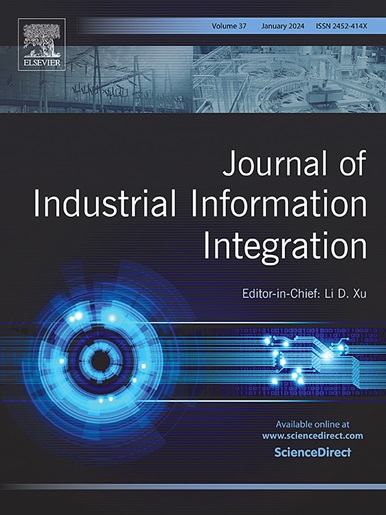通过基于深度迁移学习的神经网络数字孪生模型在数据稀缺环境中增强工业物联网性能
IF 10.4
1区 计算机科学
Q1 COMPUTER SCIENCE, INTERDISCIPLINARY APPLICATIONS
引用次数: 0
摘要
工业物联网(IIoT)连接各种工业设备,增强工人与机器之间的联系。物联网的高效管理对于保证设备的稳定运行至关重要。双数字技术连接了物理世界和虚拟世界,实现了对物理资产的实时监控和分析。本文介绍了一个数字孪生建模框架(DTwin-DTL),旨在解决工业物联网环境中数据不足的挑战。该框架利用深度迁移学习和领域对抗神经网络,促进知识从数据丰富的源领域向数据稀缺的目标领域的转移。该方法利用Informer模型对长序列时间序列数据进行有效处理,确保即使在数据有限的情况下也能准确创建数字双胞胎。该框架通过最大限度地减少建模损失并结合时间特征分析,有效地重建了虚拟空间中的物理实体。本文进一步引入了一种相似度分析方法来评估领域转移,并调整转移速率以平衡回归损失和领域自适应的贡献。使用实际电力变压器数据的实验结果证明了DTwin-DTL框架的有效性,与传统模型相比,显示出更高的预测精度。研究结果强调了这种方法在预测性维护、能源优化和其他工业物联网应用中的潜力,为资源受限的工业环境提供了可扩展和可靠的解决方案。本文章由计算机程序翻译,如有差异,请以英文原文为准。
Enhancing Industrial Internet of Things performance through deep transfer learning-based neural network digital twin modeling in data-scarce environments
The Industrial Internet of Things (IIoT) connects various industrial equipment, enhancing the connection between workers and machines. Efficient management of the Internet of Things is crucial for ensuring the stable operation of equipment. Twin digital technology connects the physical and virtual worlds, enabling real-time monitoring and analysis of physical assets. This paper introduces a digital twin modeling framework (DTwin-DTL) designed to address the challenge of data insufficiency in IIoT environments. The proposed framework utilizes deep transfer learning and domain-adversarial neural networks to facilitate knowledge transfer from source domains with abundant data to target domains with scarce data. The methodology utilizes Informer models for the efficient processing of long-sequence time-series data, ensuring the accurate creation of digital twins even in data-limited scenarios. By minimizing the modeling loss and incorporating temporal feature analysis, the framework effectively reconstructs physical entities in a virtual space. The paper further introduces a similarity analysis method to evaluate domain shift and adjusts the transfer rate to balance the contributions of regression loss and domain adaptation. Experimental results using real-world power transformer data demonstrate the efficacy of the DTwin-DTL framework, showing improved prediction accuracy compared to traditional models. The findings highlight the potential of this approach for predictive maintenance, energy optimization, and other IIoT applications, offering a scalable and reliable solution for resource-constrained industrial environments.
求助全文
通过发布文献求助,成功后即可免费获取论文全文。
去求助
来源期刊

Journal of Industrial Information Integration
Decision Sciences-Information Systems and Management
CiteScore
22.30
自引率
13.40%
发文量
100
期刊介绍:
The Journal of Industrial Information Integration focuses on the industry's transition towards industrial integration and informatization, covering not only hardware and software but also information integration. It serves as a platform for promoting advances in industrial information integration, addressing challenges, issues, and solutions in an interdisciplinary forum for researchers, practitioners, and policy makers.
The Journal of Industrial Information Integration welcomes papers on foundational, technical, and practical aspects of industrial information integration, emphasizing the complex and cross-disciplinary topics that arise in industrial integration. Techniques from mathematical science, computer science, computer engineering, electrical and electronic engineering, manufacturing engineering, and engineering management are crucial in this context.
 求助内容:
求助内容: 应助结果提醒方式:
应助结果提醒方式:


